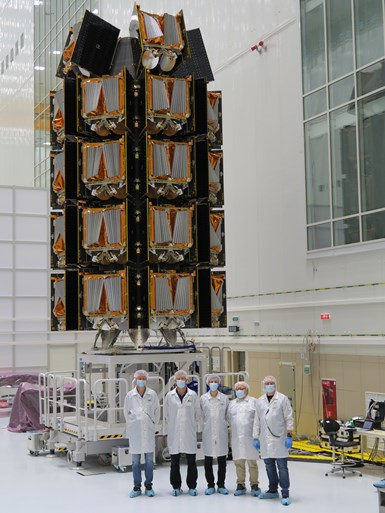RUAG Space closes in on 1,000 satellite milestone
With the separation of the latest 34 OneWeb satellites, RUAG Space is getting close to successfully placing its 1000th satellite in space.

In 2020 the Swedish space minister Matilda Ernkrans went on top of a RUAG Space dispenser in Linköping. Photo Credit: RUAG Space, Hejdlösa
RUAG Space (Bern, Switzerland; renamed to Beyond Gravity), a supplier to the space industry, and a company that employs extensive use of carbon fiber composites (see “ULA, RUAG Space extend and expand Atlas and Vulcan Centaur rocket programs cooperation”), announced on Aug. 22 that another 34 OneWeb internet satellites have been separated from the Soyuz launch vehicle and placed in orbit with a dispenser from RUAG Space. With this, RUAG Space says it has successfully placed 997 satellites in orbit, bringing the Swiss-based space supplier closer to its milestone of 1,000 satellite separations.
“This is a huge achievement which highlights the outstanding capabilities we have in satellite separation,” says Holger Wentscher, VP product group launchers at RUAG Space.
The separation systems from RUAG Space are being produced at its site in Linköping, Sweden. Similarly, the dispenser is also manufactured by RUAG Space, and makes it possible to separate multiple satellites in a specific order in order to get the exact orbit. “For us, every separation is an exciting achievement. We can offer a 100% reliability and are able to meet customer expectations in the extreme environment of space,” says Wentscher.

RUAG Space dispenser for OneWeb. A team of RUAG Space engineers supported during final works at the Russian spaceport in Vostochny in June 2021. Photo Credit: Dhelft, Arianespace
RUAG Space notes that it is a global leader satellite separation systems for commercial launch vehicles. “Our separation systems ensure that satellite and rocket remain securely attached to one another during the tough journey into space, and then deliver the valuable payloads into orbit with precision,” says Andreas Jonsson, the site manager in Linköping. The company claims that all 997 satellite separations have been carried out with a 100% success rate, and are the result of a long and trusted collaboration with NASA, the European Space Agency (ESA) and an increasingly advanced position in the commercial space industry in recent years. “We are leading the commercial market and we provide all the larger launchers in the world with equipment for launching satellites in all sizes,” adds Jonsson.
Further, RUAG Space has been developing and producing Payload Adapter Systems for around 40 years. “A period during which we have accumulated vast experience, and supplied our products to an ever-growing number of customers,” says Jonsson. “We constantly try go get better and to develop new products. Our latest product ‘Soft Separation System’ makes our separation systems useful for the next-generation satellites with better performance and lower shock.”
Related Content
-
PEEK vs. PEKK vs. PAEK and continuous compression molding
Suppliers of thermoplastics and carbon fiber chime in regarding PEEK vs. PEKK, and now PAEK, as well as in-situ consolidation — the supply chain for thermoplastic tape composites continues to evolve.
-
Composites manufacturing for general aviation aircraft
General aviation, certified and experimental, has increasingly embraced composites over the decades, a path further driven by leveraged innovation in materials and processes and the evolving AAM market.
-
Next-generation airship design enabled by modern composites
LTA Research’s proof-of-concept Pathfinder 1 modernizes a fully rigid airship design with a largely carbon fiber composite frame. R&D has already begun on higher volume, more automated manufacturing for the future.















